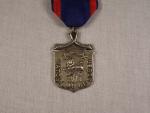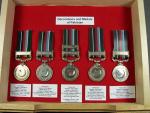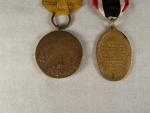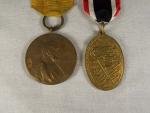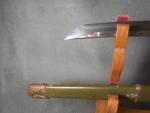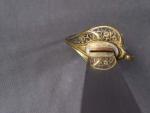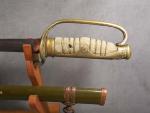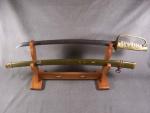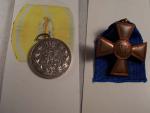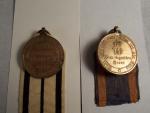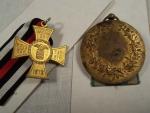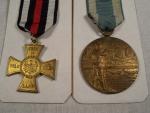-
Posts
6,486 -
Joined
-
Last visited
-
Days Won
10
Content Type
Profiles
Forums
Blogs
Gallery
Events
Store
Everything posted by Brian Wolfe
-
Hello Fellows, Anyone who has viewed my past few posts can see that I have quite a few medals with the WRONG ribbons! That's what happens when you go outside of your usual area of collecting. On the other hand I now have an interest in Imperial German medals so the trade that involved my new items was not a total loss. Here is something that has been gathering dust for about 20 years in my collection. It looked "Imperial" and that is why I bought it, but I really don't know what it is. I suspect it is for a gate post as the ring at the top looks like a chain link that you whould attach another chain to in order to keep vehicles out. I would imagine it would be mounted with the "chain link" to the side and not the top which is how I have always displayed it. It is cast iron, 7 inches tall and 3/4 inches thick. The base is threaded and there are two holes drilled in the base which I would think are there for moisture drainage. It looks too new to be a war trophy and I doubt it is actually even related to Imperial Germany. Has any of the members seen anything like this? It looks really good with my new Imperial German collection (especially the ones with the correct ribbions). Cheers Brian
-
Hello Gents, I have just received a Royal Army Temperance Medal and would like to know more about it. Of course when I say I "received it" I mean I purchased it for my collection and was not awarded it for any act of temperance on my part. After reading Chris' post on "Whiskey....why Whiskey" I am not sure many of our members would have qualified for this medal even if they were serving "back in the day". Would any of the members know the time period when this medal would have been awarded. I believe it is Victorian. The back has a Hallmark which I believe indicates it is made of sterling silver. It would have been nice if there were other Hallmarks which would have given me more information. Is the ribbon correct? I can see it is not the original but is it even correct? Thanks for any assistance you can give me. Cheers Watch and Be Sober! Brian
-
Hi Laurence, Here is a photo of my "ducks". Same tailor's copy Saichen Glacier Medal, we must shop in the same store! Cheers Brian
-
Hi Laurence, Your "ducks" look great all in a row. Sorry to hear about the Saichen Glacier Medal. Looks like we will both be looking for this same medal again. I am having some problems with medals from this dealer going astray lately but he has always been reliable in the past so I am hopping things will work out. It is good to hear that he has treated you fairly. Good luck in the hunt for the, so far, elusive official issue Saichen Glacier Medal. Cheers Brian
-

Wounded Stripe
Brian Wolfe replied to Dave B's topic in Great Britain: Research, Documentation & History
Hi Tony, I think you are probably correct. When I think back I believe we were discussing medals etc. and he was making reference to the US Purple Heart and compairing it to what the British and Canadians received for a wound. This is probably why he used the term " a thin gold thread". I've never seen one from the Second World War and he may have been wrong about the Wound Stripe being awarded in WW II. I've seen lots of photos of WW I soldiers wearing them but none from WW II. Cheers Brian -

Wounded Stripe
Brian Wolfe replied to Dave B's topic in Great Britain: Research, Documentation & History
Hello fellows, I recall my father,he was a WAG in a bomber, telling me that during WW II the Royal Canadian Air Force wound stripe amounted to a simple gold thread worn on the lower left sleeve. At the time I imagined this as a very narrow actual "thread". I've never seen one other than the WW I wound stripes in cloth and metal. Anyone know of this "thread" my father spoke of? Cheers Brian -
Hi Chris, Ouch,I could feel that in MY shoulder! Just think how fast someone back in the day could crank out the rounds. Cheers Brian
-
Hello All, I have two more medals in the lot I received on approval that I hope you can help me with. I have seen these two medals before in medal groups so I believe them to be genuine. I know the oval one is for war service but what was the larger round one awarded for? Also are these medals with the correct ribbons? When I first got this lot of 20 medals I had decided to "deal" them. Now that my fellow forum members have told me which ones are with the correct ribbons and which ones to send back I have decided to keep 15 and start a new thread in my collection. Oh come on! We all knew I would end up collecting Imperial German if I had these for a couple of days. I'm a weak man. There is no hope for me, as I believe the only cure for the "sickness" of collecting is more collecting! Cheers Brian One is a curiosity, two is a pair, three is a collection and four is an obsession.
-

Japanese Sword - Wakizashi - Edo Period
Brian Wolfe replied to Brian Wolfe's topic in Swords & Edged Weapons
Here is a close up of the tip. I hope you can see how the hamom runs out through the tip rather than along it and out the back edge. It would be nice if it didn't, as far as value is concerned. However, I think this is a good example of a well made blade being put back unto service after being broken. All in all this one sword has seen a lot of history. Starting in the classic samurai period of the 1650's, being broken and then repaired to be rehilted for the first modern battles of the 20th century during the Russo-Japanese War of 1904-05. I often wonder if this sword was carried by it's owner during WW I and perhaps even into WW II. From the Classical Samurai Period to the end of WW II is a lot of history. I should last so long! Cheers Brian -

Japanese Sword - Wakizashi - Edo Period
Brian Wolfe replied to Brian Wolfe's topic in Swords & Edged Weapons
Here is another view of the hilt, from the "business end" of the sword. Notice how the Japanese made the European style hilt their own with the addition of the cherry blossoms to the metal work. Brian -

Japanese Sword - Wakizashi - Edo Period
Brian Wolfe replied to Brian Wolfe's topic in Swords & Edged Weapons
Here is a photo of the tsuka (hilt). The ray skin wraping can be easily seen , the wire has become losened over time but it is still there. You can see the European influence in the hilt of this sword. Up to 1861 the Japanese sword was of the typical samurai style. After the samurai life style was discouraged (after 1861) the Japanese Military looked to Europe (I believe France) to pattern her new Imperial Army and Navy after. The movie the "Last Samurai", while an insult to the history of Japan, shows this period and the turmoil of change. Cheers Brian -
Hello All, Here is another specimen from my Japanese sword collection. The saya (scabbard) is the standard army issue and the handle and guard are of the Kyu-gunto style used during the period around the Russo-Japanese War of 1904-05. The exposed length of the the blade is 19 inches and makes this length of blade a wakizashi. It may seem odd to see such a short blade in a saya of this length but there is a logical expanation. It was the practice of the time to allow officers to use a "family" blade in place of the regulation issued one. In this case the officer's family blade was the wakizashi. The wakizashi is the shorter of the two swords worn by a samurai, the longer one being the katana. I'll post one of those at another time. The hamon, or temper line, can easily be seen in the photos. This is an old blade from the early Edo (now Toyko) period c. 1650. The blade was made from a broken katana. This can be seen in the photo of the tip as the hamon clearly runs out through the tip of the blade. A wakizashi that was made originally as a short blade sword would have the hamon follow the curve of the tip and run out at the back edge. Below are the particulars of this sword. This hand made blade is unsigned. Shinto blade (1597-1780), early Edo period c. 1650, made in Bizen Province (present day Okayama Prefecture. Nihunto Suguta (blade shape): Shinogi Zukuri Hamon (temper line): Midare Mune (back edge of blade): Ihori Nakago (tang shape): Futsu Nakago-Jiri (tang tip); Haagari Yasurime-mei (File marks): Taka-No-Ha Makugi-ana (tang peg hole): one Kyu-gunto mounts c. 1904-05 Saya (scabbard): SHin-gunto c. 1935, with single ashi (suspension mount). I hope you like the photos. Cheers Brian (Oh yes, regarding the "cheers face", playing with swords and beer don't mix, you may end up being known as stubby).
-
Hi Rick, Many are already in a box ready to be returned. This was part of a larger trade that was made and I was reluctant to get into a whole new area of collecting (German). I figured I would trade or sell them off in time and put the cash back into British Commomwealth, India and Pakistan medals. Many thanks to all of the members who have given me assistance with my confusing task. Cheers to all Brian
-
Hello Jacky, Thanks for the information and I probably should have use one thread for all of my questions. For me the problem is that I can be called away litterally at an moment as I am "on call" when off duty so I have tried to ask a couple of questions and then "shut down" in between in case I do get a call. Cheers Brian
-
Hi fellows, Here are a couple more Imperial German Medals I would like your opinion on. Sorry for all of the questions but I don't collect German and I am at a loss at to the indentification. The cross in the photo I am confident is a 15 year long service cross, is the ribbon correct? The medal in the photo has Friedrich August-Medaille on what I think is the obverse. The dealer has photocopied a ribbon and used this to represent the original ribbon. Is this the original ribbon, or I should say a photocopy of the original ribbon. Many thanks Brian
-
Hello All, Here are a couple more Imperial German Medals I have on approval. I have been told these two medal come from the Franco-Prussian War period. The medal on the right is marked in its edge with AUS EROBERTEM GESCHUETZ, any idea what this means? Are these copies or the real deal? Are the ribbons on these correct? Cheers Brian
-
Hello All, I have some more Imperial German medals that I would like your opinions on. The cross, I'm told, is from 1873. It is marked as such on the reverse but I am wondering exactly what it is and is it actually just commemorating a battle or event from 1873 and issued at a later date. Would this be an official issue that was worn by the soldier or is this something that was sold to the general public? The ribbon is probably wrong. The round medal is a shooting medal, I'm sure. On the reverse is stamped 2'Pr and A. I would assume it is for second place in a competition. Was this from between the wars and is it military? The shooter on the medal is in civilian clothing. Is this the correct ribbon? I hope you can shed some light on my mystery. Cheers. Brian





